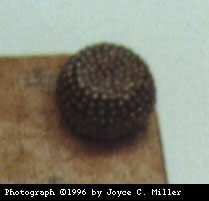







"CORPORAL BOX WITH EMBROIDERED COVER. Westphalia, 14th to 15th century. Berlin, Schloss Charlottenburg, Kunstgewerbemuseum (88.651). Height: 4.6 cm. Width: 22.4 cm. Length: 22.4 cm. Wood, originally with four (now only three) ornamental metal feet of spherical shape. Covered inside and outside with linen. The six outer sides embroidered with floss silk in green, red, blue, white, pink. The underside and side walls have similar patterns in long-armed cross stitch. The cover, illustrated, is in brick stitch. From the Treasury of Enger. Acquired from the Dionysianisches Kapitel der Johanneskirche in Herford."
The top of the box is worked entirely in brick stitch, with each stitch covering two threads. The design is made up of four kinds of diamond patterns, and their placement is diagrammed below. The "D2" type is a minor variant of "D1", and occurs only along the right-hand edge of the box. Diamond types 3 and 4 are roughly equivalent, and differ in having either a flower motif in the center, or a hackenkreuz (swastika).
The bottom and sides are covered in a continuous repeating pattern worked in long-armed cross stitch. The only variation within the pattern is whether the blue spirals within each 8-pointed star rotate clockwise or counterclockwise.
To calculate the weave of the ground fabric, I charted the entire pattern, then added up the number of stitches from left to right, and from top to bottom, then divided by the actual dimensions of the box. The bottom and sides turned out to be embroidered on cloth that is 27 tpi (threads per inch) from left to right, and 25 tpi from top to bottom. I calculated the lid to be 44 tpi across, and 26 tpi down. Thinking that this had to be wrong, I double-checked the stitching in some worn areas, and confirmed that the brick stitches do indeed cover only two threads each. The warp threads are extremely fine, and the weft is fairly thick.
The construction of the box itself is quite fine. The wooden pieces (species unknown) are a little less than 1/2" thick. Each piece was covered with pale peach-colored linen, very fine and thin, before being joined together. The cloth disappears into the joints, which are mitered, and joined in an unknown method. The finished embroidered pieces were stitched onto the linen liner of the assembled box with visible overhand stitch. There is a metal foot in three of the four corners of the box bottom, and a hole in the fourth corner. Interestingly, there is also a hole in the middle; perhaps there were actually five feet? Each foot is a metal ball, about 1 in in diameter, stippled all over with concentric rows of little bumps, and the bottom of each ball is slightly flattened.
One odd thing is that the box is "upside down," that is, when opened, the "box" is lifted away, leaving a "platform." There are no handles for lifting the box open. Presumeably one would have used both hands, or one person would have opened it and held it for another.
The box is covered by six separate pieces of embroidery. When closed, the top of the box is covered with a single square of embroidery, covered with diamond motifs. The four sides are covered with 4 long strips of the "spiral" motif. The bottom is covered with a single large square of the "spiral" motif, with the corners nicked out so that the embroidery can be brought up and around to cover the 4 edges of the "platform." In other words, the bottom square of embroidery is larger than the top square by about 1/2" all around (equal to the thickness of the wooden pieces making up the box itself).
NOTE: The Kunstgewerbemuseum is no longer located in the Charlottenburg Palace, but is now in the Kulturforum in Berlin.
 D1 = Diamond, Type 1
D1 = Diamond, Type 1Embroidery on the bottom and sides is also charted.
View or download all charts.
Back to:
Joyce's Embroidery Page
Joyce's Personal Page